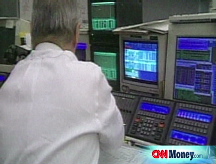Bush: 'We must act now'
Bush, Paulson outline powerful steps targeting troubled mortgage-related assets weighing down the finance industry. Plan could cost hundreds of billions.
NEW YORK (CNNMoney.com) -- President Bush and Treasury Secretary Henry Paulson on Friday outlined a series of far-reaching steps - likely to cost hundreds of billions of dollars - aimed at stemming a widening financial crisis that is roiling the financial markets and undermining confidence in the banking system.
"We must act now to protect our nation's economic health from serious risk," Bush said at a White House press conference. "There will be ample opportunity to discuss the origins of this problems. Now is the time to solve it."
"This is no time for partisanship," Bush added. "We need to move urgently needed legislation as quickly as possible without adding controversial provisions that could delay action."
Earlier, Paulson said that federal action would target the mortgage-related "illiquid assets" that are burdening the finance industry.
"The federal government must implement a program to remove these illiquid assets that are weighing down our financial institutions and threatening our economy," said Paulson. "This troubled asset relief program must be properly designed and sufficiently large to have maximum impact."
The new program would cost hundreds of billions of dollars, according to Paulson.
"This has got to be big enough to make a real difference," he said.
The plan will be fleshed out in the coming days in meetings between Paulson, other Bush administration officials and lawmakers.
"I will spend the weekend working with members of Congress of both parties to examine approaches to alleviate the pressure of these bad loans on our system, so credit can flow once again to American consumers and companies," Paulson said.
The mortgage plan is part of an extraordinary effort by the federal government to contain a financial crisis that has rocked Wall Street and has started rippling out to Main Street.
In the past week, two of the nation's most venerable investment banks - Lehman Brothers and Merrill Lynch (MER, Fortune 500) - have fallen and the Federal Reserve was forced to lend $85 billion to prevent the sudden collapse of insurance giant American International Group (AIG, Fortune 500).
Meanwhile, mainstay financial institutions are scrambling to raise cash or find merger partners as lending has frozen up and investor confidence has sunk.
In addition to the plan aimed at housing, the government on Friday announced a number of steps aimed more directly at investors and the stock markets.
The Treasury Department said it would insure money market mutual funds for finance firms that pay a fee to participate in a temporary program.
Bush said that "recent stresses cause some to question whether" money market deposits are safe. He said the plan will include government insurance for money markets.
"For every dollar invested in an insured fund, you'll be able to take a dollar out," Bush said.
Separately, the Securities and Exchange Commission took what it called "emergency action" and temporarily banned investors from short-selling 799 financial companies.
"What we had, in effect, was a dam that was sprouting lots of cracks and lots of leaks," said Bernard Baumohl, chief global economist for The Economic Outlook Group. "For the last several days, the Federal Reserve and the Treasury were trying to plug each of these holes as they were appearing. What they decided to do today was to put up a whole new dam."
This is the federal government's most far-reaching intervention in the financial markets since the Great Depression of the 1930s.
"They did what they had to do," said Baumohl. "They were facing a Category 5 financial hurricane that really threatened the entire global financial architecture."
The downside to the plan is its enormous cost, said Baumohl, estimating that the federal bail-out of the financial markets could swell the national deficit to $1 trillion annually.
So far, investors welcomed the news on Friday. The Dow soared 400 points at the start of Friday trading, after having surged 410 points on Thursday when speculation of the bailout started to grow. This included meteoric rises for battered finance firms like Morgan Stanley (MS, Fortune 500), Goldman Sachs (GS, Fortune 500) and Washington Mutual (WM, Fortune 500). ![]()



